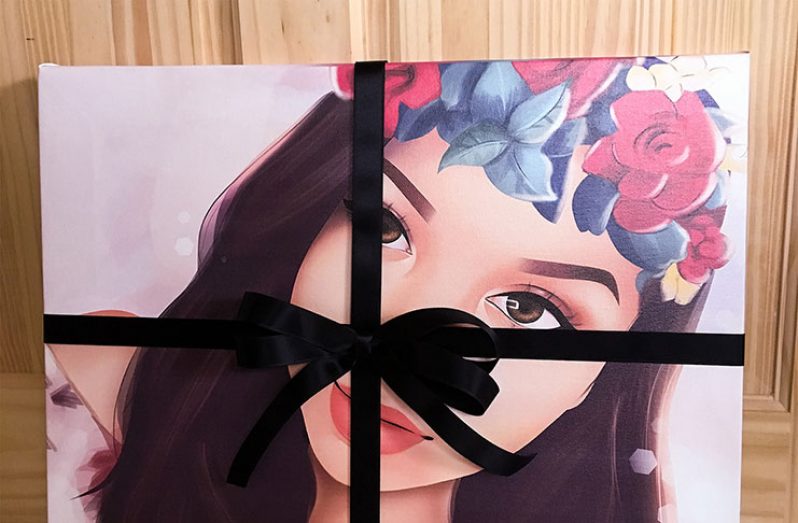By Gibron Rahim

EVERY child is an artist. The problem is how to remain an artist once he grows up.”
THE above quote by the great Pablo Picasso is a reminder of how much is lost when we grow up. Art, in all its forms, allows both artist and viewer to see the world through a different lens. Tricia Harris is among those artists who are using modern means to create artwork that remains firmly planted in this spirit.
Tricia told the Pepperpot Magazine that she thought she would have to leave art behind when she successfully graduated from St Joseph’s High School in 2015. “I never would have thought that a year after I would be working on developing it more than ever,” the now 19-year-old full-time digital artist said. Referring to the aforementioned quote by Picasso, the artist related that, like every child, she would do a lot of drawing. She recalled taking school exercise books that she no longer used and filling up any blank pages that were left with drawings. Though these early drawings might not have been the best, Tricia related that at one point she was very proud of them as they brought her a lot of happiness.
Throughout her school life, Tricia would always be excited about art class. It was, she noted, definitely her favourite class. “Even when the teacher didn’t show up to class,” she said, “I didn’t hesitate one bit at taking out my pencils and sketch pad, just to create something, anything, just to get my imagination flowing.” She recalled that from Third to Fifth Form, since she drew a lot, her teachers would always call on her to work on drawing or painting projects for the school. Eventually, this led to her participating in multiple art competitions, winning several, and being part of teams that made banners and flyers for school sports and other school events. “That brought me great joy and made my self-confidence improve,” Tricia stated.
Unfortunately, Tricia decided not to pursue Visual Arts as a subject in Fifth Form. She explained that it was close to exam time and at the time she was not confident that she was ready to write the subject at the CSEC level. She opined that the lack of attention paid to the visual arts department at her school contributed to many students not wanting to take up art, noting that in her year, sadly, only a single student from her school wrote Visual Arts at CSEC. For this reason, Tricia advocates for a strong Visual Arts curriculum. “It’s one of those subjects that you learn to use your imagination, think creatively and create something from a blank piece of medium.”
After completing secondary school, Tricia found a nine-to-five job. After working at that first job for about three months she realised that it was suffocating her creative thoughts. She felt put in a box, one where it was wrong to be creative. “I found myself slowly forgetting what it was like to draw,” she said. She could not see herself continuing to perform the job’s repetitive tasks for the next few years of her life. Then, one evening, Tricia came across a digital artist on Facebook. Her interest was sparked and that very same week she bought a book on creating digital art online and read it from cover to cover. “After then I never had a second thought about doing digital art and developed a strong love for it, even if it meant having to sacrifice some things that were in the way in order to pursue it,” she stated emphatically.
Tricia realised early on that acquiring the materials she would need for her art were going to cost some money. As a result, her journey truly began in June 2016 when she applied for another job where she worked tirelessly for about six months, sacrificing some of her wants and buying herself the equipment. Tricia also discovered Instagram in 2016 but it was in January 2017 that she began to post her work on the platform, gaining some recognition and seeing her following grow slowly but consistently. She received a lot of positive feedback and many persons asked her to digitally paint their photos. The evident joy her clients felt with her artwork made her happy. “That kept me motivated to post and post as often as I could,” explained Tricia. “That’s when I knew I wanted to be a digital artist.”
Proudly self-taught, most of Tricia’s knowledge about digital art and drawing comes from the many online articles, YouTube video tutorials, books and online learning websites she spent time watching. “But knowing all of these would be pointless unless I had taken the time to put in the hours of practice which came along with tons of trial and error,” she made clear. She has also taught herself to create flyers and banners for her social media pages. Tricia noted that the main inspiration for creating artwork comes from observing the works of other artists and photographers. “I’m always intrigued by the way they can take a blank canvas and a surprisingly messy sketch and create something beautiful,” she explained. “I think creating art is the closest I’ve gotten to experiencing magic firsthand.”
Feedback and collaboration from artists, creators and commenters play the most important role in the way Tricia’s art is produced. She said, “I was fortunate to meet some very kind people and organisations that shared my work and gave me some recognition on the art platform.” She receives many tips on how she can improve her work and in turn, she freely shares her knowledge and art experience with her followers.
Digital art, Tricia noted, is a fairly new way of creating art pieces. A digital pen is used to draw on a tablet instead of a pencil or paintbrush. Tricia related that it does require getting comfortable working in front of a screen and using a mouse, pen or screen tablet, such as an iPad, and also knowing one’s way around a drawing application. “But once you get over the anxiety and get used to sketching on this medium,” said Tricia, “you’ll be far on your way to creating some breathtaking masterpieces.”

The initial apprehension of digital drawing could be compared to being given paint, a paintbrush and a blank canvas and asked to make a Mona Lisa according to Tricia. She had never used painting software before. “The ‘undo’ button was my friend as I’m sure I would’ve ripped through the page of a sketchbook by the amount of erasing I did,” she recalled. Eventually, after some hours of practice, Tricia learnt to navigate and got used to working with the software. She acknowledged that the first few drawings were, in her words, “terrible”. “I got anxiety and wanted to quit many times and revert back to traditional sketching but I stuck to it and I’m happy I did.” After a few months, she saw herself improve.
Tricia has been doing canvas prints of her artwork for about eight months now. In that she has already done over 50 prints and will be doing many more in the coming months. She related that the process is very simple. The most important part is creating an artwork with the appropriate size and correct colour proofing just so that the printed colours are similar to the onscreen ones. She then sends the artwork to the printer for further colour proofing and printing once no errors are found. She explained that she usually has the frame made beforehand to suit the size of the print. The print is stapled and has its hooks applied, then packaged and sent to the client.
Tricia spends her typical days working on pieces. She also related that she loves replying to messages she receives and sharing tips and tutorials on her page for those who are new to digital art or are just curious. She emphasised that she is grateful to each member of her community of followers who support her and give her lots of feedback, suggestions and lots of encouragement. “I’m very excited for the future seeing that I am still very young,” she said. She hopes someday to have her own art gallery and start her own art charity programme. “And, of course, never stop drawing.” Tricia’s best advice for artists and upcoming artists is, “Draw every day, even if it’s just a tiny doodle, keep the energy flowing.”
Tricia Harris can be contacted via Instagram @tricia.art where her artwork can also be viewed.



.jpg)








